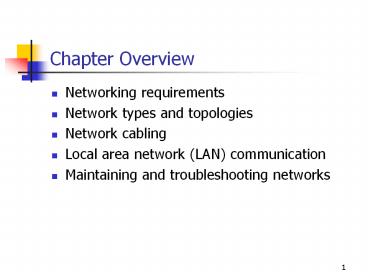Chapter Overview PowerPoint PPT Presentation
Title: Chapter Overview
1
Chapter Overview
- Networking requirements
- Network types and topologies
- Network cabling
- Local area network (LAN) communication
- Maintaining and troubleshooting networks
2
Basic Requirements of a Network
- A network links computers for communicating and
sharing information and resources. - A network must provide
- Connections
- Communications
- Services
3
Local Area Networks
- Cover a limited distance
- Allow sharing of data, peripherals, software, and
storage
4
Wide Area Networks
- Span relatively large areas
- Typically consist of two or more LANs
- Are connected using telephone or leased lines
5
Types of Networks
6
Star Topology
7
Bus Topology
8
Ring Topology
9
Network Operating System
- Network operating systems (NOSs) provide the
ability to share file, print, and other services. - Computers can be servers, clients, or both.
- The two types of NOSs are add-ons and built-in.
10
Network Interface Cards (NICs)
- Provide the physical connection between the
computers expansion bus and the network cable - Boost the digital signal from the computer
- Change the data stream from wide stream to narrow
stream (parallel to serial conversion) - Move data to and from random access memory (RAM)
and manage the flow of data to and from the
network cable - Buffer the data from the computer
11
Installation of the NIC
12
Network Cabling
13
Specifying the Right Cable
14
LAN Communication
- Ethernet uses Carrier Sense Multiple Access with
Collision Detection (CSMA/CD) as well as bus
topology. - Token ring allows only the station holding the
token to transmit data.
15
Network Protocols
- A protocol is a set of rules that govern network
communication. - A protocol suite is a group of protocols that can
be used together. - The standard protocols are
- Internetwork Packet Exchange/Sequenced Packet
Exchange (IPX/SPX) - Networked Basic Input/Output System/NetBIOS
Enhanced User Interface (NetBEUI) - Transmission Control Protocol/Internet Protocol
(TCP/IP) - AppleTalk
- Data Link Control (DLC)
16
Extending a LAN
- Repeaters
- Bridges
- Routers
- Gateways
17
Maintaining and Troubleshooting Networks
- Reduced bandwidth
- Loss of data
- Slow loading of programs and files
- Unauthorized software
- Traffic overloads
- Common mode failures
- Network security violations
18
Network Certification
- Microsoft Certified Product Specialist (MCPS)
- Microsoft Certified Systems Engineer (MCSE)
- Certified Novell Administrator (CNA)
- Certified Novell Engineer (CNE)
19
Chapter Summary
- A network provides connections, communications,
and services. - Networks are either peer-to-peer or server-based.
- Network topology types are star, bus, and ring.
- A NIC connects the computer to the network.
- Network cable types are twisted-pair, coaxial,
and fiberoptic. - A network protocol provides the rules for network
communications. - Networks can be extended with repeaters, bridges,
routers, and gateways.

